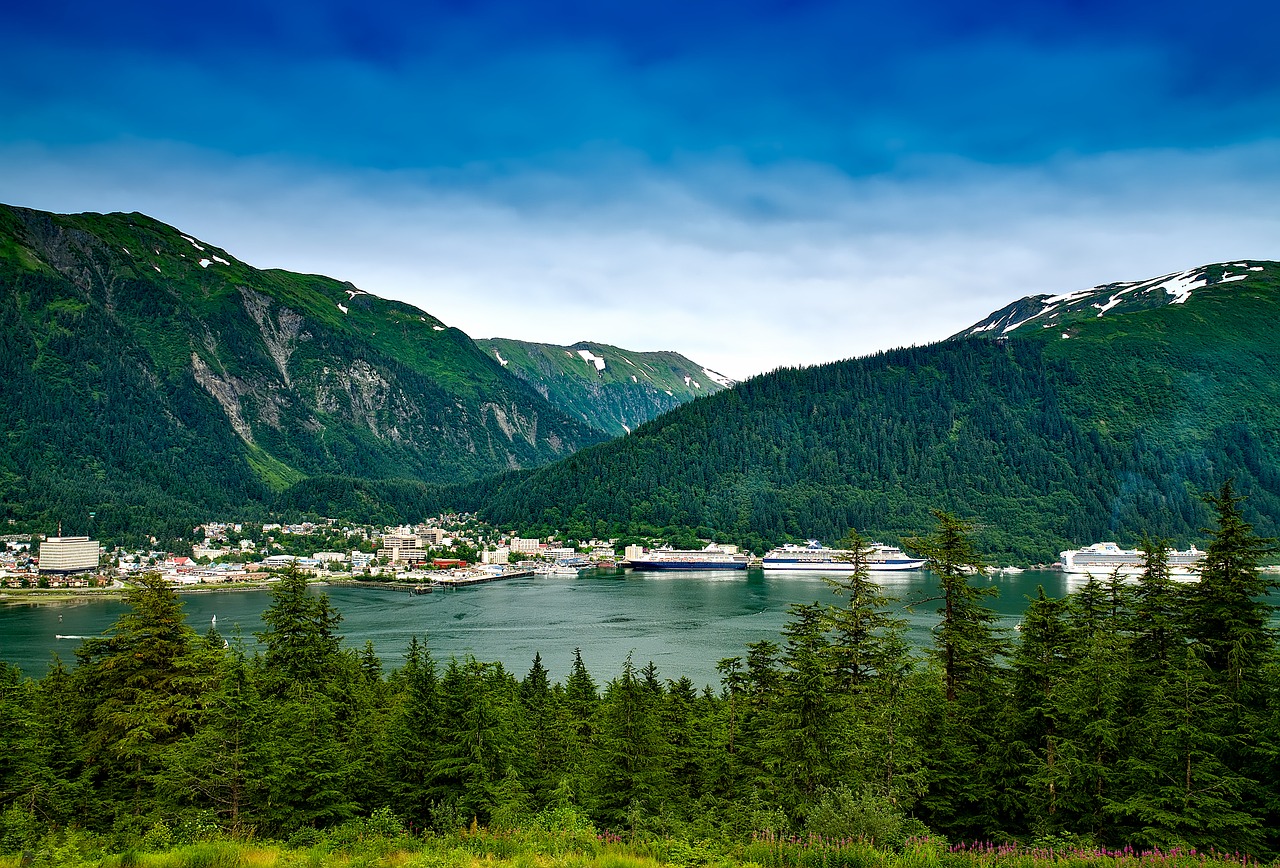
The City and Borough of Juneau (/ˈdʒuːnoʊ/) JOO-noh; Tlingit: Dzánti K'ihéeni [ˈtsántʰì kʼìˈhíːnì]), commonly known as Juneau, is the capital city of Alaska. Located in the Gastineau Channel and the Alaskan panhandle, it is a unified municipality and the second largest city in the United States by area. Juneau was named the capital of Alaska in 1906, when the government of what was then the District of Alaska was moved from Sitka as dictated by the U.S. Congress in 1900.[3][4]
Juneau is unique among U.S. capitals in that there are no roads connecting the city to the rest of the state. Honolulu, Hawaii, is the only other state capital not connected by road to the rest of North America. The absence of a road network is due to the extremely rugged terrain surrounding the city. Downtown Juneau sits at sea level, with tides averaging 16 feet (5 m), below steep mountains about 3,500 feet (1,100 m) to 4,000 feet (1,200 m) high. Atop these mountains is the Juneau Icefield, a large ice mass from which about 30 glaciers flow; two of these, the Mendenhall Glacier and the Lemon Creek Glacier, are visible from the local road system. The Mendenhall glacier has been gradually retreating; its front face is declining in width and height.
Juneau Alaska stands on one of the largest wilderness areas in the United States. Here you can spend your time viewing wildlife, taking the fishing trip of your life, exploring atop glaciers or enjoying the city’s shops, restaurants and artistic flare.
Riding the Mount Roberts Tramway is essentially the Eiffel Tower of Juneau -- that touristy thing you kinda have to do. At the top you’ll have a panoramic raven’s-eye view of the city and its surrounding channels and islands (see if you can spot which tiny cruise ship is yours). But no landscape is more powerful or strange to behold than a glacier carving through sharp-ridged mountains. Mendenhall Glacier, about 12 miles from downtown, is the most Alaska thing you’ll see here -- a giant white sheet of ice, slowly flowing downhill from high up in the Coast Range mountains behind Juneau into Mendenhall Lake. The enormous weight of the glacier compresses the ice and forces out air bubbles, giving it a deep blue color visible in the cracks in its surface. You can kayak up to its 70-foot-high face, walk onto the icy expanse with a guide, or simply take in the view from nearby trails. Mendenhall Glacier is melting faster than it grows and receding back into the mountains, a process that’s speeding up due to climate change. Soon it will no longer calve ice chunks into Mendenhall Lake.
Nearly half of Juneau's working population is employed by the federal, state, or local government. All state departments have offices in Juneau, including the Superior and District Courts. A large federal building houses the regional headquarters of several federal agencies. Those with the largest number of workers are the U.S. Forest Service, National Park Service, National Marine Fisheries Service, Bureau of Indian Affairs, U.S. Fish and Wildlife Service, U.S. Postal Service, and the U.S. Coast Guard. It is estimated that for each government worker, one private sector job is needed to supply the services required by the government workers. Tourism is the largest private-sector employer. The number of non-Alaskan visitors to Juneau tops 800,000 each year, accounting for about half of the total Alaska visitor market. The majority of visitors travel between May 1 and October 1, though year-round travel is growing. During that time, the harbor is filled with cruise ships bringing tourists from the "Lower 48" and around the world. Commercial fishing and fish processing are another important sector of the local economy. Salmon hatcheries and a cold storage facility operate in town, the latter processing two million pounds of salmon, halibut, black cod, and crab annually. Transportation and trading are the other important sectors of the economy. Manufacturing jobs had been almost nonexistent but that area has become a focal point for government programs resulting in a growth spurt.
Kenneccott Greens Creek Mine, on Admiralty Island near the city, produces gold, silver, lead, and zinc, and is one of the largest silver mines in North America. In December 2004 an environmental impact study was completed allowing for the Kensington Gold Mine project to proceed. It is expected to create about 200 construction jobs for two years, then roughly 250 positions for its 10 to 15 years of operation.
Small business owners usually struggle with expansion plans against meager cash flows. That’s why First Down Funding is a critical part of small business development in Juneau. Get Pre-approved in minutes for a small businesss funding in Juneau. Apply online or contact us so we can expedite your request. We are your Juneau Business Funding source. Apply today for business funding in Juneau.